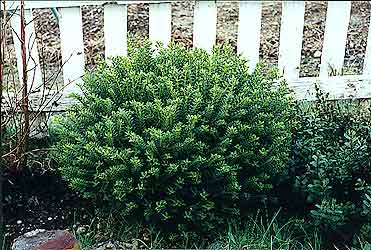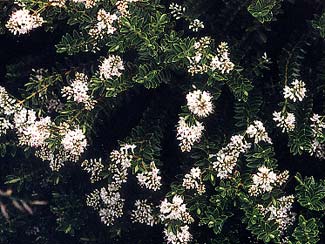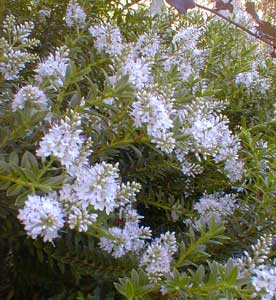 Boxleaf Hebe,
Boxleaf Hebe,
a versatile year-round delight
The Boxleaf Hebe (Hebe odora, formerlyHebe buxifolia & H. anomala) is occasionally called Boxleaf Veronica because its blooms slightly resemble racemes of Veronica, a close relative. The buds are many & green the first week in June, with the flowers in full display into early summer.
The shrub as shown at the top of the page is a December 2001 portrait. The twigs visible to the left are from a 'Diablo' ninebark that has lost all its purple leaves for winter. There's another hebe visible to the right; that one is Hebe 'Autumn Glory' which has since been moved to a different location. Since that winter 2001 photo was taken the shrub has more than doubled in size, & has become part of a veritable wall of mixed shrubs.
 The second photo is of the same Hebe in bloom, taken July 2002; & the third photo shows the blooms in June 2004.
The second photo is of the same Hebe in bloom, taken July 2002; & the third photo shows the blooms in June 2004.It has dense bright green foliage year round & is fond of the sun in our temperate area, but in hotter climates would need to be protected in partial shade.
It can also suffer from extreme cold, but could survive up close to a house to get some residual warmth from the building. In a truly temperate zone like here on Puget Sound it is ideal & hardy, even though it is sometimes difficult elsewhere.
This New Zealand native can grow to five feet height. It can stand a great deal of spring pruning to restrain it's height or to shape it for topiary effect or to create a hedge. But pruning is entirely optional, as this Hebe is never unruly & naturally forms a rounded shape.
Boxleaf Hebe has yellow twigs under the glossy green foliage. Althugh ours has small white flowers, there is also a pink-blooming variety, & another with purple blossoms & burgundy twigs. There's even a dwarfed variety grown as a groundcover.
 It can be cultivated from greenwood cuttings taken in late summer, or from seed that was first allowed to dry right on the shrub.
It can be cultivated from greenwood cuttings taken in late summer, or from seed that was first allowed to dry right on the shrub.The genus is named for the Goddess Hebe, also known as Ganymeda. She was the Goddess of Youth & barer of the ambrosial cup of immortality on Olympus, as well as a groomswoman who haltered the horses for the chariot of her mother, Hera. In Greek myth She is something of a maidenly aspect of Hera, eventually dwindled to the role of wife to Heracles, but this weakened portrait coopts a mightier figure of rival cults. But throughout the ancient near east She was Hepa or Hepatu, a mighty & warlike Earthmother & all-seeing Sun-goddess who closely resembled Cybele, rode about the world standing upright on the back of a panther or lioness, & had a city for a crown. She is recalled in Genesis as Hawah or Eve, the Mother of All.
Greek myth seems to symbolize an Olympian overthrow of the older cult of Hepatu. For instance, when her brother Ares returns from battles, according to Homer, Hebe served as a washerwoman cleaning her brother's body & his garments. Eventually, Hebe fell down & spilled a cup of the ambrosia of immortality, & was so humiliated by her clumsiness that she resigned her position & went to live upon the earth. In this shaming-myth of Hepatu's fall & humiliation is nevertheless imbedded the acknowledgement that immortality was originally hers to give even to the gods. Thus Pindar called her Sovereign Hebe, & herald of Aphrodite.
Even such humiliating myths as Hebe's stumbling fall echo something of a paleolithic Cybele, for her voluntary return to the Earth is like Cybele's refusal to join the Olympians, to dwell on the world as foremost ruler instead of sharing power with her son Zeus above. Thus in the Dionysiaca, we have a prayer to the earth-dwelling Hebe begging that she bring the Cup of Immortality to humanity. So too in the Genesis story, whrein Eve but not Adam knows the secret of immortal youth from the Tree of Life, Adam is cast from the Garden (like Heracles from his temporary position on Olympus), but Eve is never said to have been cast out. Rather, she voluntarily followed after Adam, to continue as his helper. God could no more cast out Eve than could Zeus cast out Cybele, but both chose to dwell upon the earth.
Like Hepatu or Cybele, Hebe was a maenad. Maenads covered themselves in ivy & serpents & raged across the countryside in honor of Cybele. According to Pausanias, Hebe had a festival called Kimrorjsot, the Ivy-cutting Festival. According to Strabo & Pausanius, she had important temples & a hilltop citadel at Phlios (Argos), Mantinea in Arkadia, besides being worshipped within sundry cults of of Hecate, Hera, & Aphrodite. So for all her seemingly dwindled status in Olympian state myths, in practice Hebe's own cult had not declined.